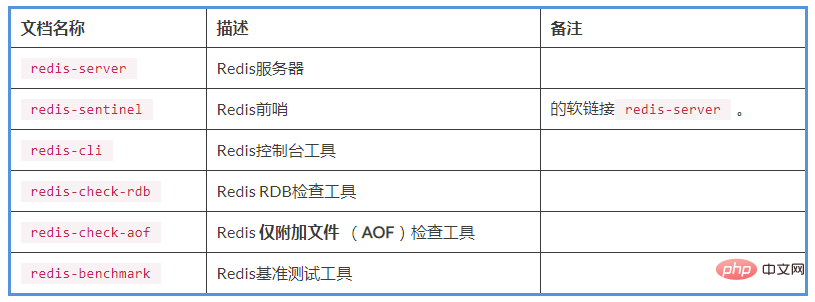Redis download and install
The following column Redis Tutorial will introduce you to the specific steps of Redis download and Redis installation. I hope it will be helpful to friends in need!

Redis Download and Install
Redis has an active community on GitHub. Over the years, a large number of pull requests have been raised and merged, and the author Antirez always provides timely responses in the issues section of GitHub. Therefore, the release cycle of Redis is very fast. They are widely used from the early versions 2.6/2.8 to 3.0/3.2 to the latest 4 versions. Each version provides some basic enhancements and bugfixes. Therefore, it is one of the best practices to use the latest version of Redis if possible.
In this book, we use the latest version of Redis 4.0.1.
Redis is an open software written in pure C language, so we can install it by compiling. Major operating systems also include Redis binary packages in their software repositories, although the Redis versions are often out of date.
1: Prepare!
You can find the download link and basic installation steps at https://redis.io/download. If you want to build Redis by compiling source code in Linux/Unix/macOS, you need the gcc compiler and the C standard library libc in your environment. When installing the OS repository, all you need is an Internet connection and the correct repository configuration.
2: How to do it?
We will demonstrate the compilation and installation of Redis in Ubuntu 16.04.2 LTS (Xenial Xerus). The download and build steps are as follows:
Set up the build tool:
$ sudo apt-get install build-essential
Create a directory and enter Redis:
$ mkdir /redis $ cd /redis
Then, download Redis:
$ wget http://download.redis.io/releases/redis-4.0.1.tar.gz
Solution Zip and enter the directory:
$ tar zxvf redis-4.0.1.tar.gz $ cd redis-4.0.1
Create a directory for the Redis configuration file and copy the default configuration file into it:
$ mkdir /redis/conf $ cp redis.conf /redis/conf/
Establish dependencies:
$ cd deps $ make hiredis lua jemalloc linenoise $ cd ..
Note
Due to differences between the various operating systems and libraries installed on them, the above steps will be required when an error occurs indicating that something is not met. For example, you may encounter the error message: zmalloc.h:50:31: fatal error: jemalloc/jemalloc.h: No such file or directory. For most environments, this step is not necessary if there are no issues with the dependencies in question. .
Compiling:
$ make
If all goes well, the following message will be displayed. This means that the compilation was completed successfully:
It's a good idea to run 'make test' ;) make[1]: Leaving directory '/redis/redis-4.0.1/src'
Installing Redis:
$ make PREFIX=/redis install
The following message means that the installation was successful:

Enter the /redis directory and verify that the Redis binary has been generated:
$ ls /redis/bin redis-benchmark redis-check-aof redis-check-rdb redis-cli redis-sentinel redis-server
Congratulations! You have completed the compilation and installation of Redis.
Compared with compiling and installing, apt-get is much easier to install Redis in Ubuntu. Let’s take a look:
First, update the software repository index:
$ sudo apt-get update
Then start the installation:
$ sudo apt-get install redis-server
Once completed, check if Redis is set up in your environment :
$ which redis-server
Three: How does this work?
When choosing a Redis version, remember that Redis follows standard versioning conventions, which is the major.minor.patch level. Even-numbered minors represent stable versions, while odd-numbered minors represent unstable versions, although some versions of Redis use odd-numbered minors.
The difference between building Redis by compiling and building from a software repository is that the former can add optimization or debugging options at compile time and also has the flexibility to specify the installation location during the installation process.
After installation, there are some executable files in the bin directory. Their descriptions and instructions are shown in the table below:

Four: And more!
For Windows, you can get the Redis version for Windows, which is maintained by the Microsoft Open Technologies group:
https://github.com/MicrosoftArchive/redis/releases .
Simply download the .msi executable file and double-click to install, keeping the default configuration.
For macOS, the process is not much different than in Linux. You can also install Redis by issuing the brew install redis command on macOS.
The above is the detailed content of Redis download and install. For more information, please follow other related articles on the PHP Chinese website!

Hot AI Tools

Undresser.AI Undress
AI-powered app for creating realistic nude photos

AI Clothes Remover
Online AI tool for removing clothes from photos.

Undress AI Tool
Undress images for free

Clothoff.io
AI clothes remover

AI Hentai Generator
Generate AI Hentai for free.

Hot Article

Hot Tools

Notepad++7.3.1
Easy-to-use and free code editor

SublimeText3 Chinese version
Chinese version, very easy to use

Zend Studio 13.0.1
Powerful PHP integrated development environment

Dreamweaver CS6
Visual web development tools

SublimeText3 Mac version
God-level code editing software (SublimeText3)

Hot Topics
 Solution to 0x80242008 error when installing Windows 11 10.0.22000.100
May 08, 2024 pm 03:50 PM
Solution to 0x80242008 error when installing Windows 11 10.0.22000.100
May 08, 2024 pm 03:50 PM
1. Start the [Start] menu, enter [cmd], right-click [Command Prompt], and select Run as [Administrator]. 2. Enter the following commands in sequence (copy and paste carefully): SCconfigwuauservstart=auto, press Enter SCconfigbitsstart=auto, press Enter SCconfigcryptsvcstart=auto, press Enter SCconfigtrustedinstallerstart=auto, press Enter SCconfigwuauservtype=share, press Enter netstopwuauserv , press enter netstopcryptS
 Analyze PHP function bottlenecks and improve execution efficiency
Apr 23, 2024 pm 03:42 PM
Analyze PHP function bottlenecks and improve execution efficiency
Apr 23, 2024 pm 03:42 PM
PHP function bottlenecks lead to low performance, which can be solved through the following steps: locate the bottleneck function and use performance analysis tools. Caching results to reduce recalculations. Process tasks in parallel to improve execution efficiency. Optimize string concatenation, use built-in functions instead. Use built-in functions instead of custom functions.
 Golang API caching strategy and optimization
May 07, 2024 pm 02:12 PM
Golang API caching strategy and optimization
May 07, 2024 pm 02:12 PM
The caching strategy in GolangAPI can improve performance and reduce server load. Commonly used strategies are: LRU, LFU, FIFO and TTL. Optimization techniques include selecting appropriate cache storage, hierarchical caching, invalidation management, and monitoring and tuning. In the practical case, the LRU cache is used to optimize the API for obtaining user information from the database. The data can be quickly retrieved from the cache. Otherwise, the cache can be updated after obtaining it from the database.
 Caching mechanism and application practice in PHP development
May 09, 2024 pm 01:30 PM
Caching mechanism and application practice in PHP development
May 09, 2024 pm 01:30 PM
In PHP development, the caching mechanism improves performance by temporarily storing frequently accessed data in memory or disk, thereby reducing the number of database accesses. Cache types mainly include memory, file and database cache. Caching can be implemented in PHP using built-in functions or third-party libraries, such as cache_get() and Memcache. Common practical applications include caching database query results to optimize query performance and caching page output to speed up rendering. The caching mechanism effectively improves website response speed, enhances user experience and reduces server load.
 How to use Redis cache in PHP array pagination?
May 01, 2024 am 10:48 AM
How to use Redis cache in PHP array pagination?
May 01, 2024 am 10:48 AM
Using Redis cache can greatly optimize the performance of PHP array paging. This can be achieved through the following steps: Install the Redis client. Connect to the Redis server. Create cache data and store each page of data into a Redis hash with the key "page:{page_number}". Get data from cache and avoid expensive operations on large arrays.
 How to upgrade Win11 English 21996 to Simplified Chinese 22000_How to upgrade Win11 English 21996 to Simplified Chinese 22000
May 08, 2024 pm 05:10 PM
How to upgrade Win11 English 21996 to Simplified Chinese 22000_How to upgrade Win11 English 21996 to Simplified Chinese 22000
May 08, 2024 pm 05:10 PM
First you need to set the system language to Simplified Chinese display and restart. Of course, if you have changed the display language to Simplified Chinese before, you can just skip this step. Next, start operating the registry, regedit.exe, directly navigate to HKEY_LOCAL_MACHINESYSTEMCurrentControlSetControlNlsLanguage in the left navigation bar or the upper address bar, and then modify the InstallLanguage key value and Default key value to 0804 (if you want to change it to English en-us, you need First set the system display language to en-us, restart the system and then change everything to 0409) You must restart the system at this point.
 Can navicat connect to redis?
Apr 23, 2024 pm 05:12 PM
Can navicat connect to redis?
Apr 23, 2024 pm 05:12 PM
Yes, Navicat can connect to Redis, which allows users to manage keys, view values, execute commands, monitor activity, and diagnose problems. To connect to Redis, select the "Redis" connection type in Navicat and enter the server details.
 How to find the update file downloaded by Win11_Share the location of the update file downloaded by Win11
May 08, 2024 am 10:34 AM
How to find the update file downloaded by Win11_Share the location of the update file downloaded by Win11
May 08, 2024 am 10:34 AM
1. First, double-click the [This PC] icon on the desktop to open it. 2. Then double-click the left mouse button to enter [C drive]. System files will generally be automatically stored in C drive. 3. Then find the [windows] folder in the C drive and double-click to enter. 4. After entering the [windows] folder, find the [SoftwareDistribution] folder. 5. After entering, find the [download] folder, which contains all win11 download and update files. 6. If we want to delete these files, just delete them directly in this folder.






